Abstract
What If Learning is a pedagogical approach that allows teachers to deliver traditional content, as prescribed by national curricula, while at the same time promoting character virtues fundamental to Christian ethos. It encourages teachers to present topics from a different perspective, which shapes understanding through the lenses of cooperation, coaching or hospitality. What If Learning reframes ‘how’ to teach rather than changing ‘what’ to teach. This study tested the effects of a three-months-long What If Learning intervention which reshaped the delivery of lessons to reflect values of hospitality and welcome in twenty schools across five dioceses in the United Kingdom. Four hundred and seventy-four pupils and 198 of their teachers filled in online surveys presenting implicit and explicit measures of intergroup attitudes adapted from the existing literature to reflect our operationalisation of tolerance as the Christian virtue of hospitality or welcome. Data were collected from all participants at three time points: before and after the intervention and then again three months later. Analyses of variance revealed a pattern of answers largely supportive of the positive effect of the proposed pedagogical approach, although not always consistent with the hypotheses. Teachers report overwhelming positive effects of the intervention on several aspects of pupils’ behaviour and flourishing potentials. The discussion focuses on the widespread implications of these findings while acknowledging the need for additional research to strengthen our conclusions and promote the approach even further.
1. Introduction
Governments, educators and major sponsors of education have an enduring interest in the moral impact of education, whether in terms of security and anti-terrorism, social benefit or philosophy of education. This is commonly expressed through national values initiatives and, in the case of school sectors sponsored by religions, religious ethics. Education has become the site of attempts to counter extremism. Religion is cast as a security threat [1,2,3].
In England, over 1.8 million children are educated in publicly funded schools of a religious character, the vast majority of which are Christian. These schools negotiate their identity and ethos to satisfy the interests of government and public accountability, as well as their religious foundation. They seek a settled understanding of what educational ‘success’ in moral matters is.
Schools in England are directed by the UK government to promote character education in line with British values [4]. The choice and expression of these values are a matter of considerable debate. In the UK, there was a change from values expressed in human rights language to a more nationally framed historical and political articulation [5]. One area of debate has been around the inclusion of tolerance, identified by the UK Government Department for Education as a fundamental British value. This attracts considerable debate and political controversy because of difficulties around intrinsic value [6,7]. Philosophically, there is a need to distinguish that which it is necessary to tolerate and that which should not be tolerated. Politically, the concept is tainted by overtones that position those who are ‘other’ as needing to be tolerated by the majority. A further area discussed more broadly in moral education is the impact of attempts within the curriculum to shape or influence pupils’ moral development, as opposed to other factors external to school interventions.
What If Learning (www.whatiflearning.com, see Supplementary materials) is a virtue led approach to pedagogy developed by an international team of academics and educators which focuses attention on the learning experiences that teachers design rather than the content of the curriculum that they teach as the significant feature for Christian Education [8,9,10]. It can be used by any subject teacher with any age group. At its heart are two questions: ‘what vision of being human frames the teacher’s design of learning activities?’ and ‘what do pupils imagine they are doing when learning subject content?’ The approach is now widely used in Church of England schools, where it is particularly linked to character education [11]. This area subsequently became a core feature of education policy as the 2019 Ofsted inspection framework prioritised curriculum intention, and some believe this is a result of influence from the Church of England education policy which in turn was influenced by What If Learning [12].
Church of England schools are an established part of the state-funded education system. However, as the demographics of England change, with less people attending church and more self-identifying as non-religious, this funding has become increasingly controversial [13]. One of the criticisms is that such schools segregate children from contact with those of other faiths and cultures and that, by implication, they nurture tribal, ‘othering’ attitudes and do not promote community cohesion or prepare children to embrace the religion and belief diversity characteristic of modern democracies. In this particular project, the research team wanted to find out whether What If Learning could contribute to promoting more inclusive attributes amongst pupils attending Church of England schools.
Tolerance may be a practical operating principle in terms of the government’s promoted British values, but it is not an obvious moral virtue, making association with character education difficult or controversial and leaving dilemmas for school leaders and teachers in how to implement a counterseal value in their curriculum. This research offers insight into how policy in education can be reframed by communities to counter contextual or intrinsic limitations. It provides a road map for the appropriation of values education from national politics to serve community interests. The research team focused on the two pairs of attributes ‘tolerance and respect’ and ‘neighbourliness and community spirit’ in the DfEs’ list of desired attributes. They set the following research question: ‘Can What If Learning support teachers of diverse subject specialisms in promoting the development of the attributes of tolerance, respect, neighbourliness and community spirit in Church of England schools?’ During the project set up, questions were raised by the participating schools about the idea of tolerance. Concern was expressed that it could be interpreted as a grudging response to others, and the suggestion was made that a more welcoming response was required in a Christian context. The virtue of hospitality is a theme of increasing significance in Christian theology [14,15], and it was, therefore, decided to use this as the core virtue for promotion through the project. This reframing of an educational objective from a Christian theological perspective is fundamental to the What If Learning pedagogy. The notion of hospitality was then analysed so that the teachers participating in the project would have a clear idea of the different attributes that could be developed, with particular emphasis given to what is entailed in combatting ‘othering’ attitudes to those we perceive as different from ourselves. Examples are:
- Humility;
- Being good listeners;
- Being able to explain why certain things are important to others;
- Being good welcomers;
- Offering friendship to those they perceive as somehow different from themselves;
- Expressing their own views with respectful conviction;
- Being able to adapt to unfamiliar circumstances in appropriate ways;
- The desire and ability to promote the common good.
This was not intended as an exhaustive analysis of the Christian understanding of the virtue of hospitality, but rather a guide for the participating teachers in deciding how that virtue might be interpreted in the context of Church of England schools seeking to promote inclusive rather than othering attitudes in their pupils. Twenty participating schools were recruited and introduced to What If Learning, with an explanation of the virtue of hospitality and help in designing a learning intervention with some illustrative examples. Teaching interventions took place between September and December, 2015. In planning these, teachers were asked to use three questions that reflected the components of the What If Learning approach:
- How can a Christian understanding of hospitality provide a different way of seeing a lesson/unit?
- How could the pupils engage with this new way of responding to diversity through the learning experiences teachers design?
- How could teachers change their own practices to create a hospitable response to diversity?
The hypothesis behind What If Learning is that, by using these questions in planning learning activities, teachers can introduce simple changes to the standard curriculum that encourage perspective taking, questioning life’s purpose, enhancing appreciation and gratitude and other similar dispositions that result in a greater display of the various traits characteristic of hospitality.
The qualitative dimension consisted of visits to twelve of the schools for extended interviews with the participating teachers. Each school also submitted a portfolio of work, and these were reviewed alongside the interview data. Details of this qualitative work are published in three reports [16,17,18,19]. The rest of this article describes the quantitative dimension of the project where we sought to develop a methodology that provided reliable measures of the development of the virtue of hospitality.
2. Social Psychological Perspectives
Hospitality, as defined and operationalised so far, has a very strong theme of positive interpersonal and intergroup relations running through it. There is a wealth of psychological perspectives that has focused on the theoretical and empirical understanding of intergroup relations, in-group and out-group bias, prejudice and stereotyping [20,21,22]. It was, therefore, decided to draw on this literature as it resonated with our conceptualisation of hospitality as the opposite of in-group bias and prejudice, the negative phenomenon that we called ‘othering’. The theoretical construct of Social Identity Complexity [23,24] and the empirical approach known as the Ambiguous Situation [25] were chosen as two examples of research methodology that could illuminate our research question.
Given the difficulty usually associated with the measurement of socially and ethically complex and loaded attitudes (such as those representing the components of hospitality), we drew from the previously discussed psychological literature in an attempt to measure attitudes in an indirect way using implicit tools. First, Social Identity Complexity refers to the nature of the relationship between the various group identities that an individual might hold. A single social identity is that part of one’s self concept that comes from membership of a specific social group and that inclines one to define oneself in term of such group membership (such as being Christian, British, female or even a Leeds United supporter) and identify with the associated characteristics shared by members of that group. People, however, hold several different social identities at the same time. Some of these refer to groups that are ascribed, such as gender and nationality, while others represent chosen groups, such as the football/soccer team one decides to support. Others may be a complex mix of assigned and chosen, for example, the faith or belief system a person follows. These different social identities, however, do not exist in isolation from one another. While some have a clear relationship with each other, where, for instance, one is the superordinate level of the other (as in the case of Christians and Church of England social identities, where all Church of England members are presumably Christians), others might just partly overlap. For example, some British people belong to the Church of England but not all of them do; the two social identities overlap but not completely. In general, when an individual’s social identities are independent (which is to say they do not overlap), we can say that the resulting Social Identity Complexity is high. Empirical research has supported the idea that higher Social Identity Complexity promotes positive intergroup relations and increases social tolerance [26]. This is based on the reasoning that individuals with higher Social Identity Complexities are aware of the differences between individuals, they are able to experience for themselves the implications of holding numerous and separate identities and are therefore more willing to empathise with different perspectives and to be flexible, which are all necessary requirements of a hospitable attitude. It was, therefore, postulated in this study that the development of hospitality would be associated with an increase in measured Social Identity Complexity following an intervention to promote it using What If Learning [23,27].
A second tool for measuring intergroup attitudes that has been well received when dealing with participants of a younger age is the Ambiguous Situation Task [25]. According to the empirical evidence available, children display different intergroup attitudes by choosing from a series of statements the one which best describes their perception of what is represented in a drawing that depicts two children in an ethically ambiguous situation. We used four such pictures (see Appendix A). The advantage of such implicit measures, when compared with the alternative Implicit Association Tests [28], is that the respondent is encouraged to refer to a naturalistic setting which encompasses a real life social situation [25]. They are also not just self-reporting their own attitudes, an approach which raises questions about the accuracy of the judgments they make, but are rather revealing their implicit attitudes through their response to an everyday situation.
Finally, taking the opportunity to gather further information about the effectiveness of What If Learning, we also administered surveys with the teachers delivering the intervention. We monitored teachers’ attitudes towards the intervention itself, the support received during the intervention and their perception of its effectiveness.
The two sub-questions we investigated were:
- Whether the intervention using the What If Learning approach promoted any change in pupils in regard to the development of the virtue of hospitality as defined by the project, namely as the disposition to respond in a more open and positive way to those that they might perceive as different from themselves.
- Whether the intervention promoted any changes in teachers in terms of their confidence and ability to engage in character education using the What If Learning pedagogy as part of the mission of a Church of England school.
3. Method
There were three data collection points. A baseline questionnaire was administered before the teachers began their classroom interventions in October 2015; a second version of the questionnaire was administered after the intervention finished in December 2015. During the intervention period, teachers designed classroom work that sought to promote the Christian virtue of hospitality, having been introduced to the project by their diocesan adviser through bespoke training. No further training was given in the following weeks. A final data collection took place at the end of the academic year in July 2016, when the teachers had undergone several more months of using the approach with their classes.
Data were collected from 9–13 year-old pupils in the 20 participating Church of England schools. At the first data collection point, 474 pupils completed a valid questionnaire giving the baseline; this number dropped to 420 after the intervention at data collection point 2 (an 11% drop out rate), and 245 at data collection point 3 (a 49% drop out from time 1 and 42% drop out from time 2). Participants’ numbers are not reported for individual analyses but these of course vary from time to time, depending on how many participants provided valid answers to each question. Of the 245 pupils who completed all three waves of data collection, 47.8% were female, 51.4% were male and 0.8% were not sure; 90.6% were white, 2% were black, 5.7% were Asian and 1.7% were Indian; and 71.4% said they belonged to the Church of England, whereas 28.6% said they did not. We also collected data from 198 teachers at baseline; 92 of them also provided data at collection point 2 (a 54% drop out rate) and then 71 at collection point 3 (a dropout rate of 64% from time 1 and 23% from time 2).
Each school made its own decision as to exactly when to complete the questionnaire, depending on the project schedule they had agreed with their adviser. For all data collection times, the schools made arrangements so that children had access to computers and were given the URL address to complete the online questionnaire, which was supported by the Qualtrics platform containing all the relevant measures. Pupils were only allowed to take part in the study if the school office had received a signed consent form from the child’s parent or guardian. The questionnaire was explained to the pupils via a written document provided by the researchers, thus ensuring the same information was presented consistently to all pupils across the 20 schools. Similarly, teachers were supplied with a URL address for the teachers’ version of the online questionnaire, but they completed it in their own time. All participants were assured of their anonymity and the voluntary nature of the study at each data collection point on the first page of the questionnaire. Each pupil was given a randomly generated ID code that was allocated by their school office, thereby ensuring their anonymity in the research. Participants were also assured that they could withdraw from the study at any point.
The pupils’ questionnaire included the following sections:
- A page where the study was briefly described and pupils were asked if they belonged to the Church of England or not and about their gender and their ethnicity.
- A measure of Social Complexity. Participants were asked to rate the overlap between each couple of identities provided, for instance, how many British people were also Christians or how many Christian people were also female. The questions referred to three social identities (British Nationality, Christian religion and gender identity) and all possible permutations and orders for a total of six questions per gender group (Qualtrics presentation filters were used to ensure that female participants, for instance, were presented with female relevant questions only). The scoring was done by coding the answers with a scores ranging from 1 to represent maximum overlap and therefore low complexity all the way up (“all”) to 5 to represent minimum overlap and therefore high complexity (“none”). Participants’ six answers were then averaged so that the final score associated a higher level of social complexity with a higher total score because it was more representative of independent social representations; that is, groups that are not perceived as necessarily overlapping.
- A measure of intergroup attitudes using the Ambiguous Situation measure. For each of the four pictures (see Appendix A), children were asked to rate how bad or good the behaviour performed by the ‘perpetrator’ was (using a sliding scale represented by a smiley/frowning face). Prior to the questionnaire administration, the research team had identified the most neutral of the four statements as scoring 1 and the most negative one as scoring 4. A higher score represented more willingness on the part of the pupil to interpret the behaviour in the picture negatively and a greater disposition to make negative inferences about the character’s behaviour when there would have been the option to see it as positive, being an ambiguous situation. Children were also asked to choose what they thought the ‘perpetrator’ would do next from a list of four behaviours. The final question then asked pupils to rate how good or bad such an expected behaviour was.
- A matrix question where each pupil rated how good they thought the children in their class were in relation to a series of seven behaviours characteristic of hospitality such as making others feel at home, being good listeners and understanding someone else’s feelings. For this, a scale ranging from 0 (very poor) to 100 (excellent) was used.
The baseline teachers’ questionnaire included the following sections:
- A question asking how familiar they were with the What if Learning approach;
- A question asking how often their lessons focused on character development;
- A matrix question asking how often pupils in their class displayed evidence of each of the 11 behaviours used to conceptualise hospitality in this project. This section contained a higher number of behaviours and more complex wording than the pupils’ corresponding section of explicit attitudes measures.
All questions were measured on a 0 to 100 scale.
The collection point 2 questionnaire for teachers included all of the above, plus:
- A question asking in how many lessons the teachers had used a What If Learning pedagogical intervention.
- A set of questions asking teachers to rate different aspects of the effectiveness and impact of the intervention; namely, on the way they taught other classes; on their ability to incorporate the development of hospitality; on their ability to use the pedagogy effectively; on the likelihood of the pedagogy influencing pupils’ academic performance, learning behaviour and ability to flourish.
The collection point 3 teachers’ questionnaire was identical to that of point 2 apart from one question, which asked in how many lessons the teacher had used pedagogical intervention since January 2016, which was the collection point 2 date.
4. Results: Pupils’ Qestionnaires
4.1. Social Complexity
A one-way repeated measures ANOVA showed a very small (eta square = 0.03) but significant increase in the social complexity displayed by pupils at the three times points: M1 = 2.89 s.d. = 0.59; M2 = 2.98 s.d. = 50 and M3 = 3.06 s.d. = 0.48; F(2298) = 4.538 p < 0.02. The intervention seems to have encouraged a more diverse conceptualisation of social identities as hypothesised. Moreover, this seems to continue even after the completion of the intervention period. Our hypotheses also formulated that this increase in social complexity would be associated, that is, correlated, with similar changes in levels of tolerance, both the implicit as well as the explicit ones. The reasoning was that a more complex social identity would be an antecedent of changes in tolerance attitudes. This, however, proved not to be the case. The two constructs, although they change over time as a result of the intervention, do not show reciprocal correlation. We therefore did not perform any additional analyses on this hypothesis. The two constructs change over time as a result of the intervention, but do not do so following a pattern of association or linear correlation. We did not, therefore, report further on this aspect of the research.
4.2. Ambiguous Situations
When deciding how to interpret the ambiguous behaviours displayed in the four scenarios (Appendix A), we can observe some small but statistically significant changes taking place over time (Figure 1). These were tested using Freidman’s ANOVAs. First of all, we can observe that the most visible changes take place between the time 2 and time 3 measurements. Pictures 1, 2 and 4 show statistically significant changes over time (p < 0.001). For Picture 1, the rating is changing from the option “Liz has pushed Zoe off the swing” to the option “Liz doesn’t like Zoe”, which we had initially conceptualised as a more negative option because it is expressed in more universal terms. This would imply a more negative judgement of the situation. On the other hand, the Picture 2 average rating shifted from “Sam has found Cody’s money” to “Sam is picking up money”, which is a more neutral interpretation. Similarly, for Picture 4, the mean rating shifts from “Max is distracting Zac” to “Max is looking at Zac”/“Max and Zac are taking a test”. This is a very large and positive change towards a more non-judgemental position. Of course, the nature of the behaviour displayed and the gender of the children portrayed might have influenced the shift as well as many other factors. Unfortunately, given the financial and time constraints of this project, we were unable to have a control group to confirm the role of the intervention in this change. Interviews with the children might have revealed more insights into their perceptions of the scenarios. However, the change is generally encouraging and indicates some degree of effectiveness of the intervention, with two of the three statistically significant changes being towards a more positive assessment of the characters in the ambiguous situation.

Figure 1.
Mean scores reported for each picture at three different time points. * Significant differences at p < 0.001.
When asked to rate how bad the behaviour displayed in each picture was, the trends are clearer and more consistent (Figure 2); in Picture 1, 3 and 4 pupils tend to show an initially more positive outlook following the intervention. However, over time they seem to revert to their initial opinions. The trend for scenario 2 is in a more negatively judgemental direction. Only the patterns for pictures 3 and 4, however, reach statistical significance.
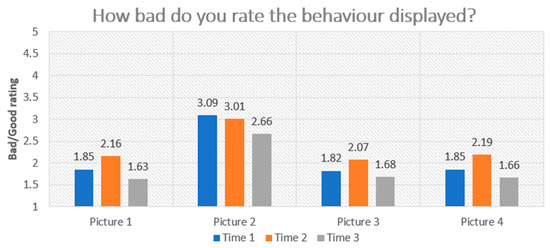
Figure 2.
Mean scores reported for each picture at three different time points. * Significant differences at p < 0.001.
Overall, pupils think that all children in the four pictures could be friends and the changeover time is almost negligible; none reached statistical significance (Figure 3).
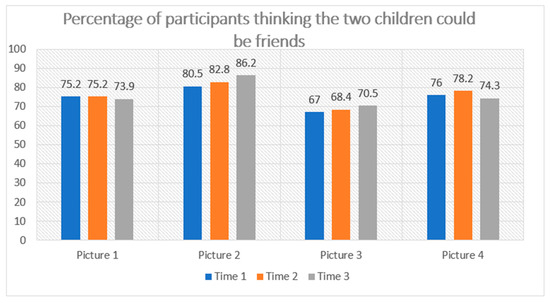
Figure 3.
Percentage of participants who believed the children in each scenario could be friends in future at three different time points. * Significant differences at p < 0.001.
In Figure 4, the patterns of answers to the questions “what do you think X and Y will do next” are more complex to analyse, and potentially they show a shift over the course of the research towards a more positive outlook on three of the four pictures (1, 2 and 3). Focusing on participants who completed all three questionnaires, we observe that what we rated as the more positive option is usually the most frequent choice. Moreover, the percentage of pupils to choose this option increases over time (picture 1 shows an increase only between time 1 and 2). For Scenario 4, however, we observe a less hospitable pattern; the more negative option is the most frequently chosen, and this frequency choice also increases over time. Overall, we can conclude that the measure has detected some very supportive attitude changes. While some of these were in the direction we expected and showed a more positive interpretation of some of the pictures (Figure 4 very clear and Picture 3 less strong but still in the expected direction), others showed no change or an unexpected more negative interpretation. Clearly more research is needed to understand the way children react to ambiguous situations depicting differently loaded behaviours.
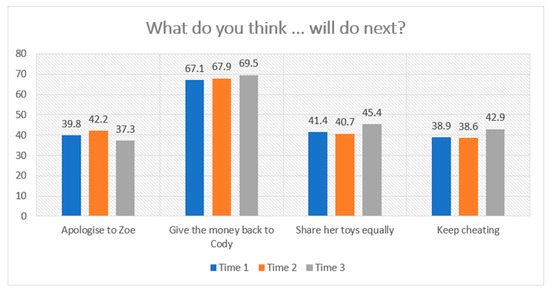
Figure 4.
Percentage of respondent who chose the specified option at each of the three different times.
Finally, in order to complement the more implicit approaches to measuring development in hospitality already described, the pupils were asked to rate explicitly, on a scale of 0–100, the degree to which the children in their class were good at exemplifying a variety of behaviours associated with hospitality. Mean ratings and the corresponding bar chart for the three data collection points are shown in Figure 5; and differences were tested via three-way repeated measures ANOVAs.
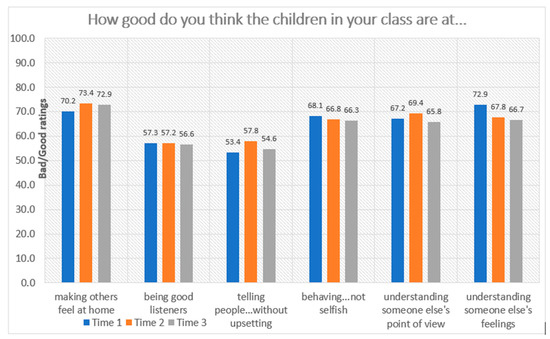
Figure 5.
Mean ratings for each of the hospitality behaviours at three different times.
None of the ratings show statistically significant changes over the period of the research, probably because there is a ceiling effect whereby the ratings are already quite high at collection point 1.
5. Results: Teachers’ Qestionnaires
In relation to their encounter with the What If Learning pedagogy, teachers reported a statistically significant increasing level of familiarity (p < 0.01), showing that, even after the researchers stopped promoting the intervention period in December 2015, teachers still continued using it (Figure 6). Similarly, they reported a statistically significant increasing level of focus on character development in their lessons across the curriculum over the academic year.
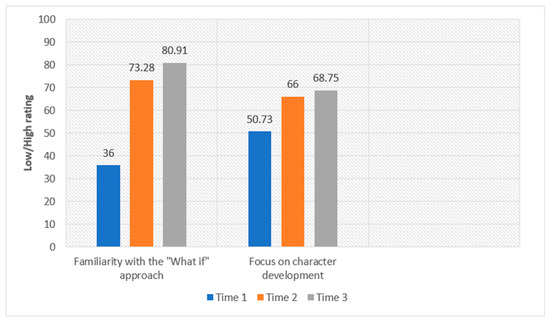
Figure 6.
Mean ratings of familiarity with the “What if Learning” approach and degree of focus of lessons on character at the three data collection points.
The teachers were also asked to rate the frequency with which pupils in their class displayed evidence of a series of attributes associated with the virtue of hospitality on a scale from 0 (never) to 100 (all the time). Figure 7 and Figure 8 show that there was a marked increase in their estimates from data collection points 1, 2 and 3. All differences represent a statistically significant (p < 0.001) increase in the display of the virtue in question.
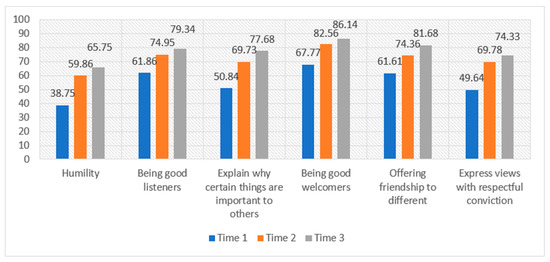
Figure 7.
Teachers’ rating of degree to which each hospitality attribute is displayed.
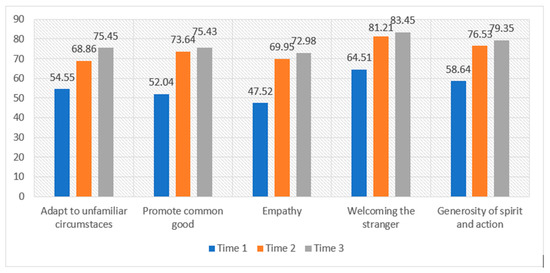
Figure 8.
Teachers’ rating of degree to which each hospitality attribute is displayed.
6. Discussion
This article reports on the attempt to measure the development, if any, of attributes associated with the virtue of hospitality when the What If Learning approach to pedagogy is used by teachers in twenty Church of England schools as part of a planned intervention. This was part of a mixed-methods project where both qualitative and quantitative methods were used. In the quantitative dimension of the project reported on in this article, both explicit and implicit approaches to measurement were utilised.
The study drew on previous educational and social psychological literature to identify two implicit measures that test the effectiveness of the What If Learning intervention in fostering the development in the pupils of attitudes and behaviours associated with the virtue of hospitality. The measures of Social Complexity indicated an increase in openness to others, but there were no links to the attributes that were taken as characteristic of hospitality. However, the results from the Ambiguous Situation Tasks show that, between the baseline data collection point and collection point 2 (during which teachers used the What If Learning approach), the pupils (a) become less likely to make negative inferences about others in the ambiguous scenarios and (b) generally demonstrate a more positive outlook on what future developments there might be in the four scenarios that were utilised. It is important to note that the time interval between the two data collection points was very short due to the time constraints imposed by the funder, and one would not expect much change in attributes in such a short space of time. When the data from collection point 3 is added in, the positive trend is continued. The results of the explicit questions that asked pupils to rate their peers in relation to hospitable attributes neither confirmed nor discredited these findings. However, pupils were generally positive about their peers’ demonstration of these attributes even though there was no statistically significant change in the ratings given over time. Finally, the unanimously statistically significant increase that the teachers reported over the period of the research in the display by pupils of all the hospitable attributes confirm the tentative indications of the effectiveness of the intervention in developing hospitable attributes that emerged from the analysis of the pupils’ questionnaires.
The results presented here represent only the quantitative data collected. Interviews with a sample of teachers and analyses of the coursework portfolios of a sample of pupils strengthen our conclusions that the teaching intervention initiated a positive shift in perspective in our participants, both pupils and teachers [16,17,18].
We finish with some observations on the conduct of the research:
- In relation to the ambiguous situations, we suspect that the pupils found them of varying challenge in terms of interpreting what was happening. For example, it seems that scenario 1 was actually easier to process than scenario 4. Unfortunately, given the time scales set by the funder, we had no opportunity to pilot these scenarios or to develop our own scenarios. We therefore used those available in the literature. It might be possible to obtain scenarios that are more meaningful by involving children directly in the development phase of the measurement tools, including the assignment of positive/negative scores to the options.
- Our participants were younger than those in the research literature about the Social Complexity and Ambiguous Situation measures, nor have these measures been administered before via an online tool. Had there been the opportunity to pilot these measures, it is likely that adaptations to our approaches would have been made to improve their quality and their ability to capture change.
- A significant shortcoming of our study is the lack of a control group. We are indeed not able to differentiate at all between the natural and random effects of time and those of our intervention because we do not know how the same (or an equivalent sample of) pupils would have developed and answered the same measures in the absence of an intervention. We were well aware of this limitation from the initial stages of this research project, but it was a practical impossibility to recruit another 20 schools for the control arm of a more complex research design given the constraints imposed by the funders’ timetable. Furthermore, we suggest that complementing the quantitative aspect of the data collection with a qualitative counterpart has, to some degree, offset this shortcoming of the research design. Having a control group as well as our qualitative data would, however, have been our ideal.
- The lack of a control group is a known limiting factor in applied research in a number of contexts, and this one is no exception. If we wanted to explore possible alternatives we would have to consider the possibility that some of the score changes we observed are due to the fact that our participants filled in the same version of the survey three times over a six to nine months period and that the measures we used were rather memorable. Young children of this age could be seen as particularly vulnerable to experimenter biases of a different sort. Still, the implicit nature of our main two measures, identity complexity and linguistic intergroup bias, should protect from such possibility. Estimating the number of people who are British while also Christian should sound like a challenge more than an expectation to answer in a prescribed way.
- What cannot be excluded is that children spoke about their answers to each other in between the three measurement times. It is still possible that a group cohesion pressure might have arisen from such discussions and that children started to perceive the need to give more positive interpretations of the neutral images presented to them.
- The strict procedures adopted to maintain participant anonymity in the collection of the quantitative data meant it was impossible to explore with participants the significance of their questionnaire responses. Linking these two sets of data may have provided a much richer understanding of what was happening in the Ambiguous Situation tasks.
This research with pupils suggests that the What if Learning pedagogy was successful in promoting the development of some, if not all, aspects of hospitality and provided a mechanism to rejuvenate tainted national values within a reframed concept of Christian virtue. This conclusion is fully supported by the quantitative and qualitative data provided by our teachers’ sample. All the teachers reported observing improvement in their pupils’ ability to display behaviours characteristic of hospitality. This set of results is strong and, when added to the other layers of findings reported here, it gives confidence that we are here observing something rather significant. Our children are indeed becoming more hospitable, more welcoming.
Supplementary Materials
The What If Learning Website contains resources linked to the project. These are available online at www.whatiflearning.com.
Author Contributions
Conceptualization, T.C. and R.B.; methodology, S.H.; formal analysis, S.H.; investigation, T.C.; writing—original draft preparation, T.C. and S.H.; writing—review and editing, S.H., T.C. and R.B. All authors have read and agreed to the published version of the manuscript.
Funding
This research was funded by the Church of England, the Department for Education of the UK Government and the Jerusalem Trust.
Acknowledgments
Thanks are given to all the participating schools and the four diocesan advisors who assisted with the link with schools.
Conflicts of Interest
The authors declare no conflict of interest.
Appendix A
The four pictures used as stimuli in the Ambiguous Situation Task:
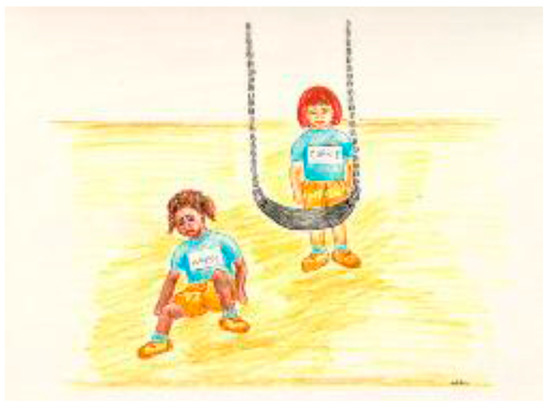
Figure A1.
Stimuli in the Ambiguous Situation Task.
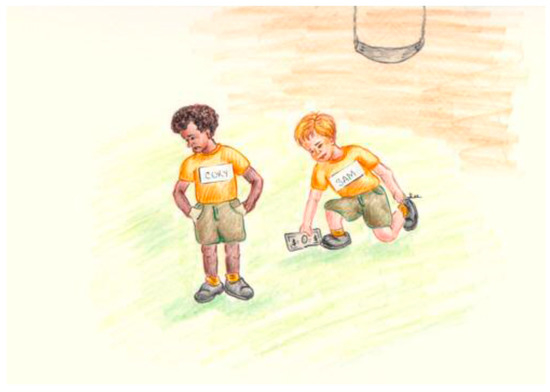
Figure A2.
Stimuli in the Ambiguous Situation Task.
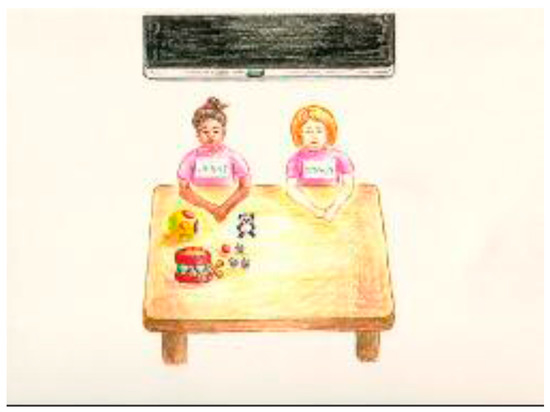
Figure A3.
Stimuli in the Ambiguous Situation Task.
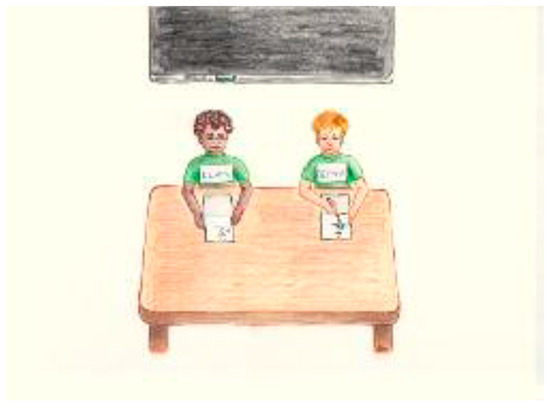
Figure A4.
Stimuli in the Ambiguous Situation Task.
References
- Niemi, P.M.; Benjamin, S.; Kuusisto, A.; Gearon, L. How and why education counters ideological extremism in Finland. Religions 2018, 9, 420. [Google Scholar] [CrossRef]
- Niemi, P.M.; Kallioniemi, A.; Ghosh, R. Religion as a human right and a security threat—Investigating young adults’ experiences of religion in Finland. Religions 2019, 10, 55. [Google Scholar] [CrossRef]
- Gearon, L.F. Religion, education, security. Religions 2019, 10, 330. [Google Scholar] [CrossRef]
- Ofsted. Education Inspection Framework; Crown: London, UK, 2019. [Google Scholar]
- Bowie, R. The rise and fall of human rights in English education policy: Inescapable national interests and PREVENT. J. Educ. Citizsh. Soc. Justice 2017, 12, 111–122. [Google Scholar] [CrossRef]
- Bowie, R. Is tolerance of faiths helpful in English school policy? Reification, complexity, and values education. Oxf. Rev. Educ. 2017, 43, 536–549. [Google Scholar] [CrossRef]
- Bowie, R. Promoting tolerance to schools in a time of extremism. In Education and Extremisms: Rethinking Liberal Pedagogies in the Contemporary World; Revell, L., Gholami, R., Eds.; Sage: London, UK, 2018; pp. 204–216. [Google Scholar]
- Cooling, T.; Green, E. Competing Imaginations for teaching and learning: The findings of research into a Christian approach to teaching and learning called what if learning. Int. J. Christ. Educ. 2015, 19, 96–107. [Google Scholar] [CrossRef]
- Cooling, T.; Green, E.; Morris, A.B.; Revell, L. Christian Faith in English Church Schools: Research Conversations with Classroom Teachers; Peter Lang: London, UK, 2016. [Google Scholar]
- Smith, D.I. On Christian Teaching: Practicing Faith in the Classroom; Eerdmans: Grand Rapids, MI, USA, 2018. [Google Scholar]
- Church of England Foundation for Educational Leadership. Leadership of Character Education: Developing Virtues and Celebrating Human Flourishing in Schools; Church of England Foundation for Educational Leadership: London, UK, 2017. [Google Scholar]
- In Unpublished Correspondence Nigel Genders, Director of Education for the Church of England, States the Chief Inspector of Ofsted Read the Church Education Policy and Subsequently Produced the Government Ofsted Guidance with Striking Similarities. For an Example see the Campaign Established by Humanists UK. Available online: https://www.justgiving.com/fundraising/nofaithschools (accessed on 10 February 2019).
- Bretherton, L. Hospitality as Holiness: Christian Witness Amidst Moral Diversity; Ashgate: Aldershot, UK, 2006. [Google Scholar]
- Smith, D.I. Learning from the Stranger: Christian Faith and Cultural Diversity; Eerdmans: Grand Rapids, MI, USA, 2009. [Google Scholar]
- Church of England Education Office. What if Learning Character Development Project: Final Report (Initial Phase). Report for the Department of Education. Church of England. April 2016. Available online: https://www.canterbury.ac.uk/education/our-work/research-knowledge-exchange/national-institute-christian-education-research/docs/nicer-what-if-learning-report.pdf (accessed on 18 December 2017).
- Church of England Education Office. What if Learning Character Development Project: Final Report. Report, Church of England. 2016. Available online: http://cofeworcester.contentfiles.net/media/assets/file/Final_Report_What_if_Learning_published_by_CofE.pdf (accessed on 10 February 2019).
- Church of England Education Office. What if Learning Character Development Project: Case Studies 2015–2016. Report, Church of England, London: UK. September 2016. Available online: http://cofeworcester.contentfiles.net/media/assets/file/Character_Development_Project_Case_Studies_2015-2016.pdf (accessed on 1 August 2020).
- Full Information on the Project with Associated Videos. Available online: https://nicer.org.uk/flourishing-schools/shaping-character-in-the-curriculum (accessed on 1 August 2020).
- Tajfel, H.; Turner, J. The social identity theory of intergroup behaviour. In Psychology of Intergroup Relations; Worchel, S., Ed.; Nelson Hall: Chicago, IL, USA, 1986; pp. 7–24. [Google Scholar]
- Brewer, M.B.; Brown, R.J. Intergroup relations. In The Handbook of Social Psychology, 4th ed.; Gilbert, D.T., Fiske, S.T., Lindzey, G., Eds.; McGraw Hill: New York, NY, USA, 1998; Volumes 1 and 2, pp. 554–594. [Google Scholar]
- Brown, R. Social identity theory: Past achievements, current problems and future challenges. Eur. J. Soc. Psychol. 2000, 30, 745–778. [Google Scholar] [CrossRef]
- Roccas, S.; Brewer, M. Social identity complexity. Personal. Soc. Psychol. Rev. 2002, 16, 88–106. [Google Scholar] [CrossRef]
- Knifsend, C.A.; Juvonen, J. The role of social identity complexity in inter-group attitudes among young adolescents. Soc. Dev. 2013, 22, 623–640. [Google Scholar] [CrossRef]
- McGlothlin, H.; Killen, M. Intergoup attitudes of European and American children attending ethnically homogenous schools. Child Dev. 2006, 77, 1375–1386. [Google Scholar] [CrossRef] [PubMed]
- Miller, K.P.; Brewer, M.; Arbuckle, M.N. Social identity complexity: Its correlates and antecedents. Group Process. Intergroup Relat. 2009, 12, 79–94. [Google Scholar] [CrossRef]
- Brewer, M.B.; Pierce, K.P. Social identity complexity and outgroup tolerance. Personal. Soc. Psychol. Bull. 2005, 31, 428–437. [Google Scholar] [CrossRef] [PubMed]
- Baron, A.S.; Banaji, M.R. The development of implicit attitudes. Psychol. Sci. 2006, 17, 53–58. [Google Scholar] [CrossRef] [PubMed]
- The Pupil Questionnaire. Available online: https://cccusocialsciences.az1.qualtrics.com/jfe/form/SV_dpoPsDswdgU9QON (accessed on 1 December 2018).
Publisher’s Note: MDPI stays neutral with regard to jurisdictional claims in published maps and institutional affiliations. |
© 2020 by the authors. Licensee MDPI, Basel, Switzerland. This article is an open access article distributed under the terms and conditions of the Creative Commons Attribution (CC BY) license (http://creativecommons.org/licenses/by/4.0/).